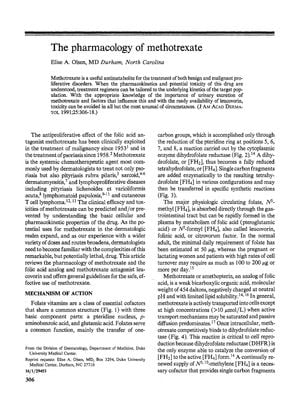The pharmacology of methotrexate
August 1991
in “
Journal of The American Academy of Dermatology
”
methotrexate dihydrofolate reductase polyglutamates leucovorin psoriasis alopecia hepatotoxicity renal failure pulmonary toxicity neurotoxicity teratogenic effects immunosuppressive effects MTX folic acid antagonist folate analog folinic acid hair loss liver toxicity kidney failure lung toxicity nerve toxicity birth defects immune suppression

TLDR Methotrexate treats various disorders by inhibiting DNA synthesis, but careful monitoring is needed to avoid toxicity and manage side effects.
The 1991 document details the pharmacology of methotrexate, an antimetabolite drug used to treat various proliferative disorders. Methotrexate inhibits DNA synthesis by binding to dihydrofolate reductase and is metabolized into polyglutamates that affect other folate-requiring enzymes. It is excreted in urine, with solubility affected by urine pH. The document highlights the importance of understanding methotrexate's pharmacokinetics to avoid toxicity, using leucovorin to mitigate side effects, and monitoring renal function. Methotrexate is used in different doses for conditions like psoriasis and malignancies, with high doses able to penetrate the CNS. Side effects vary, with gastrointestinal symptoms and hepatotoxicity being common, and liver biopsies may be necessary to assess liver damage. Cutaneous side effects include alopecia, and the drug can also cause renal failure, pulmonary toxicity, neurotoxicity, and teratogenic effects. Methotrexate's carcinogenic potential is not evident, and its immunosuppressive effects at low doses are unclear. Monitoring and managing toxicities are crucial for patients on methotrexate therapy.